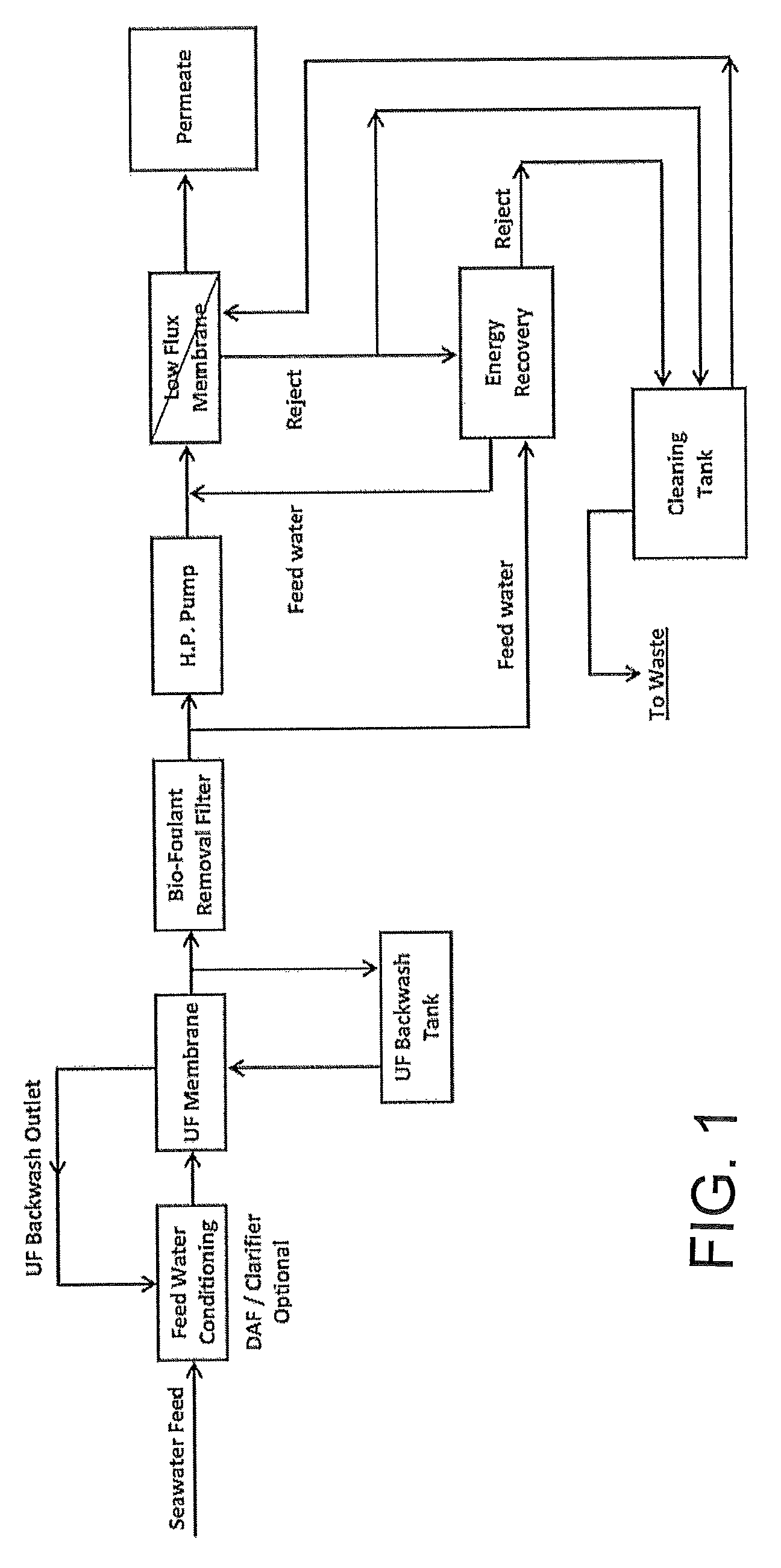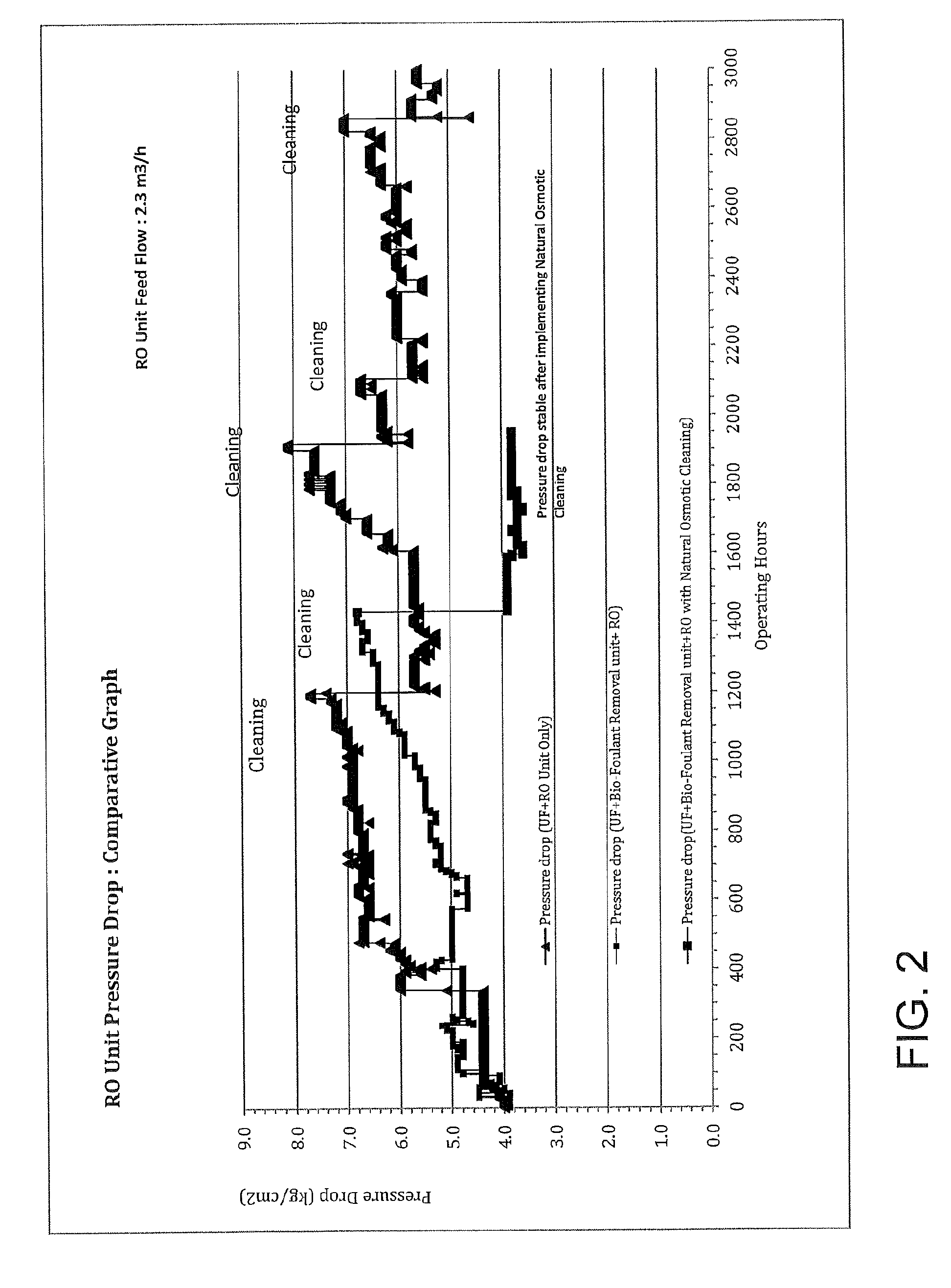Low energy reverse osmosis process
a reverse osmosis and low energy technology, applied in the field of low energy reverse osmosis process, can solve the problems of increasing energy costs, increasing energy costs, and increasing energy costs, so as to reduce biofouling on the membrane, prevent the buildup of residual biofilm, and reduce energy consumption
- Summary
- Abstract
- Description
- Claims
- Application Information
AI Technical Summary
Benefits of technology
Problems solved by technology
Method used
Image
Examples
experiment-1
[0054]To benchmark base performance, a reverse osmosis (RO) unit with 2.3 m3 / hr flow rate was operated for 17 months on surface water having TOC level of 5-10 ppm without any biofoulant removal unit at the upstream of RO unit. This source of water was selected due to its history of biofouling for several years. Based on the original plant design, the surface water was passed through an ultrafiltration (UF) unit before feeding into an RO Unit. We maintained the silt density index (SDI) below 5, most of the time below 3. The RO unit pressure drop was monitored and its results are shown in FIG. 3.
[0055]During 17 months of RO unit operation, we cleaned the unit seven times to maintain the pressure drop of the RO Unit. It was observed that the average service cycle length of the RO Unit was around 700 hrs, and it required chemical cleaning for maintaining the pressure drop, product quality and energy consumption. Operating hours of this RO unit in different service cycles are shown in Ta...
experiment-2
[0057]In this experiment, a biofoulant removal unit was installed in the UF product line, and we monitored the TOC and turbidity removal across the biofoulant removal unit. The results of TOC & Turbidity are shown in Table 2. TOC of water was analyzed on Shimadzo-TOC analyzer, and the turbidity was checked by HACH-turbidity analyzer. In this experiment the biofilter was made up of electro positive media material.
[0058]
TABLE 2Bio-FoulantBio-FoulantRemoval unitUF ProductRemoval unitUF ProductOutlet TOCTurbidityOutlet TurbidityTOC (ppm)(ppm)(NTU)(NTU)5.133.830.0690.0545.173.920.0650.0595.163.880.0670.0645.202.840.0690.0615.683.980.0680.0654.381.080.0680.065.163.980.0660.065.163.270.0710.0595.283.310.0730.0635.483.380.0660.0585.133.050.0690.0655.263.590.0650.0585.063.810.0670.064.983.020.0640.0605.133.680.0650.0615.363.820.0660.0595.863.020.0660.0605.023.120.0680.0604.823.300.0700.0605.683.820.0680.0554.581.620.0690.0595.032.910.0680.0634.282.030.0690.0565.212.910.0660.0594.282.060.0650...
experiment-3
[0060]In another set of experiments, the same RO unit of the previous examples was operated for nine months with the inclusion of biofoulant removal unit along with UF at the upstream at the upstream of RO unit and its effect was clearly observed with respect to longer service cycle length. RO unit was operated for around 1425 hours without any cleaning, which is almost twice the previous average service cycles length of Experiment 1. In this experiment the RO unit was cleaned only once after the operation of six months. RO unit performance with bio-foulant removal unit is shown in FIG. 4. During this operation it was observed that for more than 3 months there was very insignificant increase in differential pressure but once it started increasing gradually subsequent fouling rate started accelerating and progressively started increasing.
[0061]Even though the biofoulant removal unit minimized the pressure drop rise & biofouling in RO unit, still the pressure drop gradually increased ...
PUM
| Property | Measurement | Unit |
|---|---|---|
| temperature | aaaaa | aaaaa |
| flow rate | aaaaa | aaaaa |
| turbidity | aaaaa | aaaaa |
Abstract
Description
Claims
Application Information
 Login to View More
Login to View More - R&D
- Intellectual Property
- Life Sciences
- Materials
- Tech Scout
- Unparalleled Data Quality
- Higher Quality Content
- 60% Fewer Hallucinations
Browse by: Latest US Patents, China's latest patents, Technical Efficacy Thesaurus, Application Domain, Technology Topic, Popular Technical Reports.
© 2025 PatSnap. All rights reserved.Legal|Privacy policy|Modern Slavery Act Transparency Statement|Sitemap|About US| Contact US: help@patsnap.com



